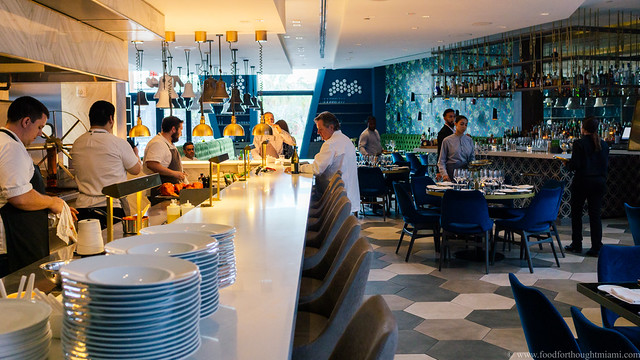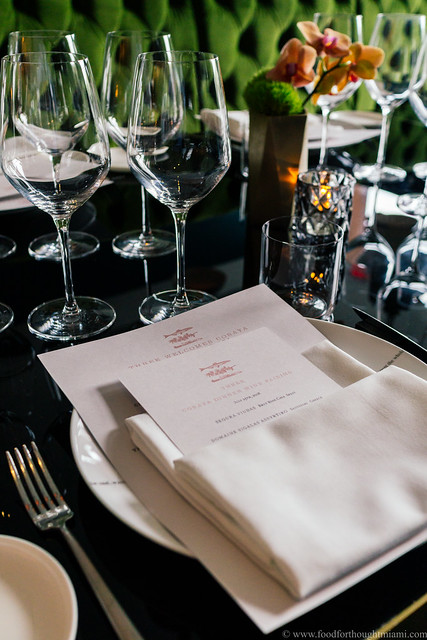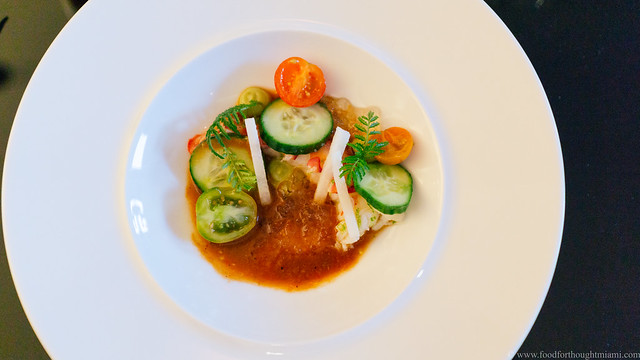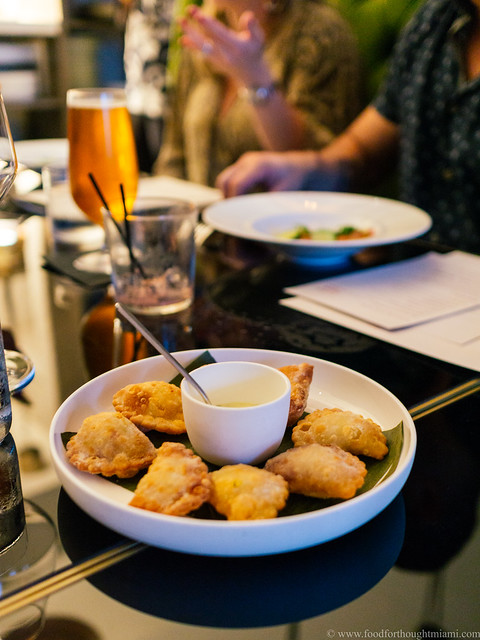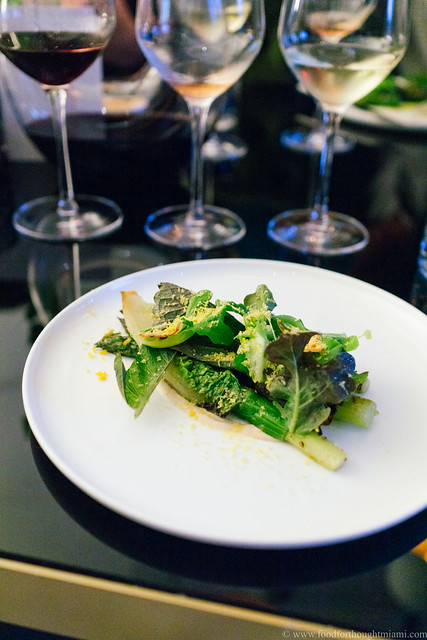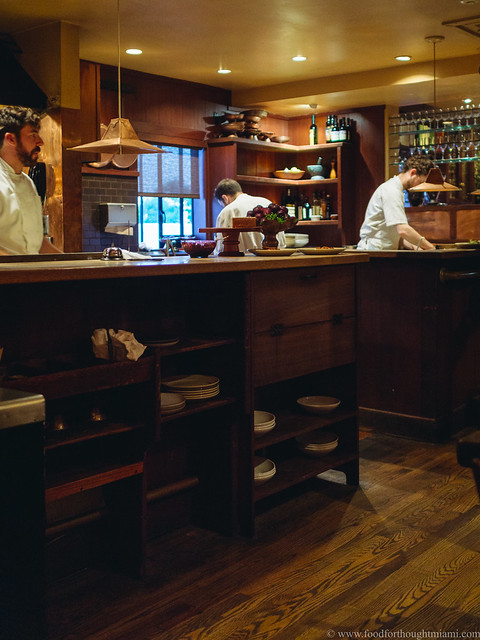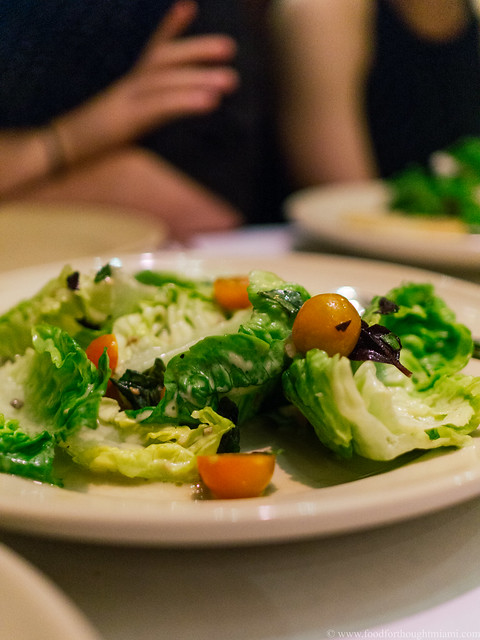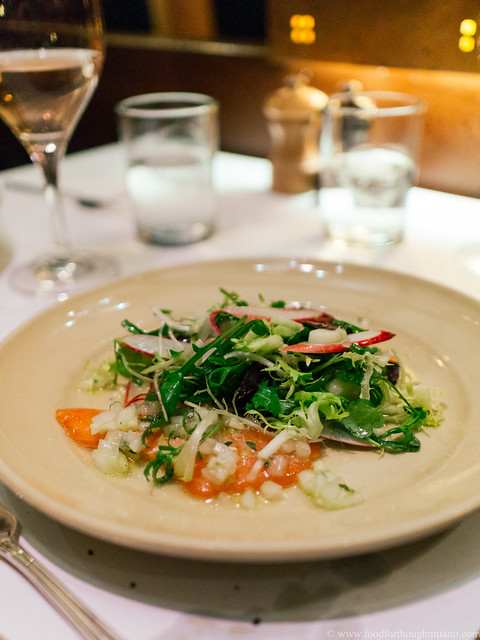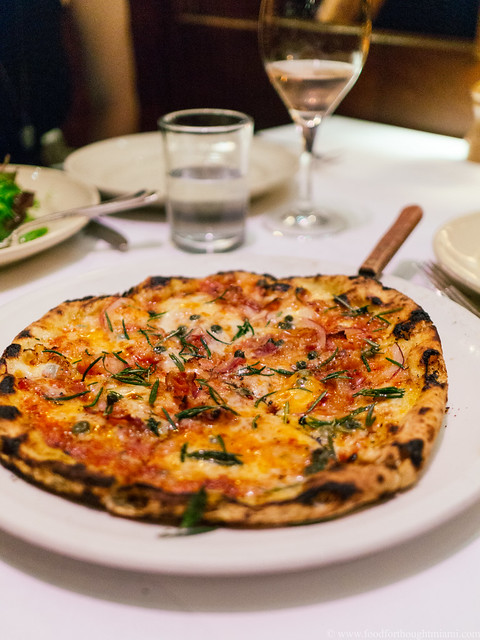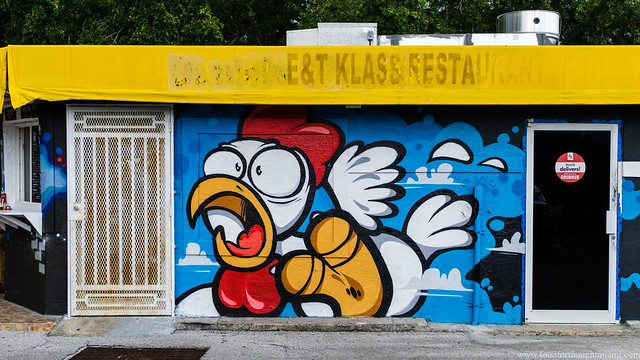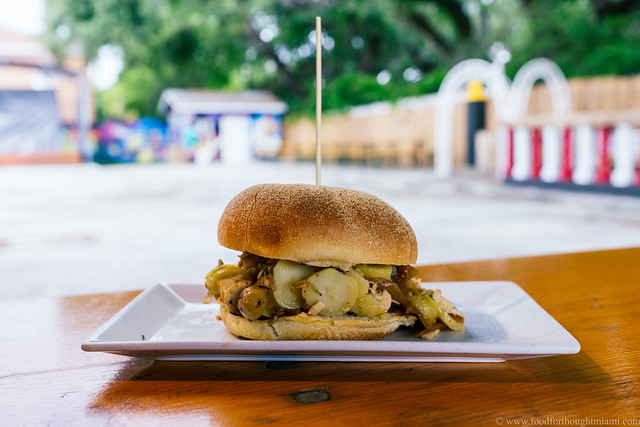Monday, September 17, 2018
Cobaya Three with Norman Van Aken
Let me just get this out of the way: Norman Van Aken has always been something of an idol of mine. One of my formative food experiences was at his restaurant A Mano, which he opened in the Betsy Ross Hotel on South Beach (now known just as The Betsy) in 1991. A Mano was Van Aken's first venture in Miami after making a name for himself at Louie's Backyard in Key West, and it was a great restaurant: fancy but not stuffy, bringing classical technique and refinement to the ingredients and flavors of Latin America and the Caribbean. If that sounds old hat now, it's a testament to the influence of Van Aken and several other chefs of that generation who helped to democratize, in a way, what we think of as fine dining.[1]
I celebrated my 25th birthday at A Mano the next year, and can still recall the "Down Island French Toast" with seared foie gras and a savory citrus caramel, the massive bone-in ribeye "gaucho" steak studded with slivers of garlic and jalapeño, and a dessert that topped ice cream with bananas cooked in rum and sugar, then laced it all with a spicy-sweet chile jelly.[2] Fresh out of law school and just starting my career, in a position for the first time in my life to really celebrate the joys of good eating on my own dime, this was how I wanted to do it.
I went back to Van Aken's restaurants as often as I could – the more modestly priced Stars and Stripes Café in the front of the Betsy Ross more frequently than A Mano, and then later his longtime flagship Norman's in Coral Gables. I bought his cookbooks, and cooked from them. And I followed many of the paths they illuminated – other chefs and writers – along the way learning a good bit of what I know about food now.
So how often do you get to ask one of your idols to cook for you? We've been trying for years to make a Cobaya dinner with Norman Van Aken happen. It finally did in late July, and it was worth the wait. This was a particularly special one for me – another dinner I'll remember for a long time. Here are some notes and pictures.
(You can see all my pictures in this Cobaya Three with Norman Van Aken flickr set).
Three, in Wynwood, actually may be my favorite of the venues Van Aken has operated since he came up US-1 from Key West.[3] Part of the Wynwood Arcade, it has a dining room that glows with plush, richly hued greens and blues, a long dining counter along the open kitchen, plus a rooftop bar (No. 3 Social) which is where we started the evening.
After plying us with cocktails – a choice of the "Hit the Deck" with vodka, habanero syrup, watermelon and mint, or the "Norman's Revenge" with tequila, lime, jalapeño and a black salt rim – we were led back downstairs to the dining room, which we'd taken over for the evening.
We started with a dish inspired by a classic Mexican[4] hangover cure, "Vuelve a la Vida," a ceviche-style seafood salad with supposedly restorative powers. This one was more refined than most, combining a chilled lobster tail, a cocktail-sauce like spicy tomato dressing, a mezcal gelée (a little hair of the dog), avocado purée, and fresh cherry tomatoes, cucumbers and crunchy jicama batons. Some crispy empanadas rode along sidecar.
I loved the next dish, which put together fat, flavorful grilled asparagus spears,[5] wispy garden lettuces, a smoked benne seed dressing, and shavings of preserved citrus. It's not always easy to give depth of flavor to vegetable dishes, but this one accomplished it.[6]
(continued ...)
Monday, July 9, 2018
Chez Panisse | Berkeley, California
Some places aren't just restaurants; they're institutions. Chez Panisse certainly falls in that category. Its founder, Alice Waters, is widely regarded as the patron saint of the "farm-to-table" movement: the restaurant, which she opened in 1971, made the sourcing of local ingredients a cornerstone long before that term was commonly used, much less beaten to death.[1] And generations of restaurants since have followed suit.
My last visit to Chez Panisse must have been about twenty years ago.[2] It doesn't seem to have changed much at all, even though the two-story Arts and Crafts style space got a major facelift about five years ago after a fire. (No doubt it helped that the architect who first designed the restaurant, Kip Mesirow, was responsible for the renovation as well.) Downstairs is the original "restaurant," which still serves a three- or four-course prix fixe menu in a sort of country French idiom that changes on a daily basis. Upstairs is the "café," opened in 1980, which offers an à la carte menu and a somewhat more casual feel. Maybe the biggest change is that both upstairs and downstairs now have open kitchens, whose wood cabinets and shelves blend so seamlessly into the rest of the space that it really does feel a bit like eating in someone's home.
(You can see all my pictures in this Chez Panisse flickr set.)
Remarkably for a restaurant that's been around for nearly half a century, Chez Panisse doesn't feel particularly dated. Indeed, aside from the farm-to-table thing, there are at least a couple other facets of contemporary dining culture where I think Chez Panisse was way ahead of the game, including those daily changing menus, and the combination of high-end food in a more informal setting. If I told you that a rustic-looking place, with a charcoal grill and wood burning oven, serving food straight from the farms, fields and docks had just opened in the East Bay, you'd probably think it was right on trend. It's a testament to the restaurant's outsize influence; and, I suppose some would say, to the stagnancy of what's come to be known as "California Cuisine."[3]
There's a reason for the genre's staying power, though: when it's done right, it's still very good, especially in Northern California, which produces some of the greatest raw ingredients on the planet. And Chez Panisse is still doing it right.
We opted for the café over the restaurant. Although it may lack the dinner party vibe downstairs, the food still captures that "of the moment" feel: while the format of the à la carte menu stays largely the same, the particular pieces change from day to day, and sometimes even from lunch service to dinner.
Some of the highlights from our visit:
A simple salad of crisp, perky gem lettuce, dotted with juicy, sweet sungold tomatoes, napped with an assertively salty, funky anchovy dressing.
A crudo of wild California king salmon with cucumbers and green coriander, accompanied by a wispy salad of greens, herbs and slivered radishes.
A pizzetta cooked in the wood oven, topped with pancetta, hot peppers, capers and fresh rosemary – great to order as an appetizer "for the table."
(continued ...)
My last visit to Chez Panisse must have been about twenty years ago.[2] It doesn't seem to have changed much at all, even though the two-story Arts and Crafts style space got a major facelift about five years ago after a fire. (No doubt it helped that the architect who first designed the restaurant, Kip Mesirow, was responsible for the renovation as well.) Downstairs is the original "restaurant," which still serves a three- or four-course prix fixe menu in a sort of country French idiom that changes on a daily basis. Upstairs is the "café," opened in 1980, which offers an à la carte menu and a somewhat more casual feel. Maybe the biggest change is that both upstairs and downstairs now have open kitchens, whose wood cabinets and shelves blend so seamlessly into the rest of the space that it really does feel a bit like eating in someone's home.
(You can see all my pictures in this Chez Panisse flickr set.)
Remarkably for a restaurant that's been around for nearly half a century, Chez Panisse doesn't feel particularly dated. Indeed, aside from the farm-to-table thing, there are at least a couple other facets of contemporary dining culture where I think Chez Panisse was way ahead of the game, including those daily changing menus, and the combination of high-end food in a more informal setting. If I told you that a rustic-looking place, with a charcoal grill and wood burning oven, serving food straight from the farms, fields and docks had just opened in the East Bay, you'd probably think it was right on trend. It's a testament to the restaurant's outsize influence; and, I suppose some would say, to the stagnancy of what's come to be known as "California Cuisine."[3]
There's a reason for the genre's staying power, though: when it's done right, it's still very good, especially in Northern California, which produces some of the greatest raw ingredients on the planet. And Chez Panisse is still doing it right.
We opted for the café over the restaurant. Although it may lack the dinner party vibe downstairs, the food still captures that "of the moment" feel: while the format of the à la carte menu stays largely the same, the particular pieces change from day to day, and sometimes even from lunch service to dinner.
Some of the highlights from our visit:
A simple salad of crisp, perky gem lettuce, dotted with juicy, sweet sungold tomatoes, napped with an assertively salty, funky anchovy dressing.
A crudo of wild California king salmon with cucumbers and green coriander, accompanied by a wispy salad of greens, herbs and slivered radishes.
A pizzetta cooked in the wood oven, topped with pancetta, hot peppers, capers and fresh rosemary – great to order as an appetizer "for the table."
(continued ...)
Wednesday, June 20, 2018
first thoughts: Sixty10 Organic Rotisserie Chicken | Little Haiti (Miami)
In the kitchen, unitaskers are anathema. All those avocado slicers and egg peelers and meat shredders just do the same things you can do with standard kitchen tools while taking up extra space in your drawers. As Alton Brown used to say on Good Eats, "The only unitasker allowed in my kitchen is a fire extinguisher."
When it comes to restaurants, though, I'm a big fan of unitaskers. Focus on just one thing, and you're more likely to do it well. Case in point: Sixty10 Organic Rotisserie Chicken, recently opened in Little Haiti. There are several items on the menu at Sixty10, but they are all essentially variations on one theme: chicken, rubbed with salt and spices, and cooked on a rotisserie until its skin is well-bronzed and its flesh pulls apart in soft, juicy ribbons. It may come as a whole, half or quarter chicken, along with a few different sandwich or salad iterations, but it's all about the bird. And happily, it's a really tasty bird.
(You can see all my pictures in this Sixty10 flickr set).
On a first-time lunch visit last week, I got the Sixty10 sandwich: pulled rotisserie chicken meat, a tangle of caramelized onions, coins of fingerling potatoes slippery with chicken jus, all smooshed inside a kaiser roll It was simple, straightforward, and delicious. The seasonings are subtle, not overpowering; it tastes like chicken, but actually like chicken, not just a bland blank canvas. Having said that, a smear of mustard or a daub of hot sauce would probably do it wonders.
I'll have to make a return visit to bring a whole roasted chicken home for the family, which can be had with two sides (options include those roasted potatoes, a creamy, tangy cole slaw, brussel sprouts or green beans) and two sauces (could be jalapeño jam, curry sauce, or pikliz, a nod to the Little Haiti neighborhood, among others) for $34. That's about 50% more than you'd pay for a commodity chicken family meal at Pollo Tropical and it's probably about 200% better.
There's not much to the place right now, which used to be a Haitian Creole take-out joint: a window into the kitchen where you place your order, a covered patio with some tables and benches if you want to "dine in." But there's a huge, sprawling yard out back, partly shaded by live oaks spreading their branches over from the neighboring property, and the owners have bigger long-term plans: live music (a stage is already set up), a chickee hut (plans have been filed with the city), wine and beer in a picnic-style atmosphere (there's no liquor license yet, so for now they're sometimes pouring wine for free).
(continued ...)
Subscribe to:
Posts (Atom)

